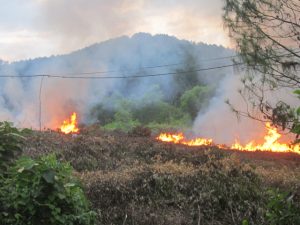
One of the many interesting aspects of the trip to My Loi in Ha Tinh province was seeing the many (some very small) acacia (Acacia hybrid) plantations and their management. While the jury seems to be out on the sustainability of short rotation plantations (acacia is typically harvested for pulpwood after as little as 5, or even 3, years), management is key in pushing the outcome one way or another. Management here can refer to several things including variety selection, length of rotation, and inter-rotation handling of the site. Nambiar et al point to the inter-rotation phase as being critical – it poses risks of soil loss and degradation, but also presents an opportunity to reset practices on a more sustainable footing.
As evidenced by the photo above, the burning of slash is a practice that hasn't completely disappeared. While there are several short term benefits to this - mobilization of nutrients for the subsequent planting phase, for example - it is unsustainable in the long run, evidence showing that 'retention of aboveground biomass supports higher and sustained productivity' (Nambiar et al). It also, of course, leaves the ground and the layer of ash prone to erosion, particularly on steeper slopes.
Notwithstanding some problems, acacia seems to have been an economic boon to many smallholder farmers, 'providing rural households with an opportunity to diversify their farm enterprise and to make more profitable use of poor land' (source).
Links:
http://ageconsearch.umn.edu/bitstream/113223/2/ias27.pdf
http://www.cifor.org/publications/pdf_files/Books/BCIFOR1104.pdf
